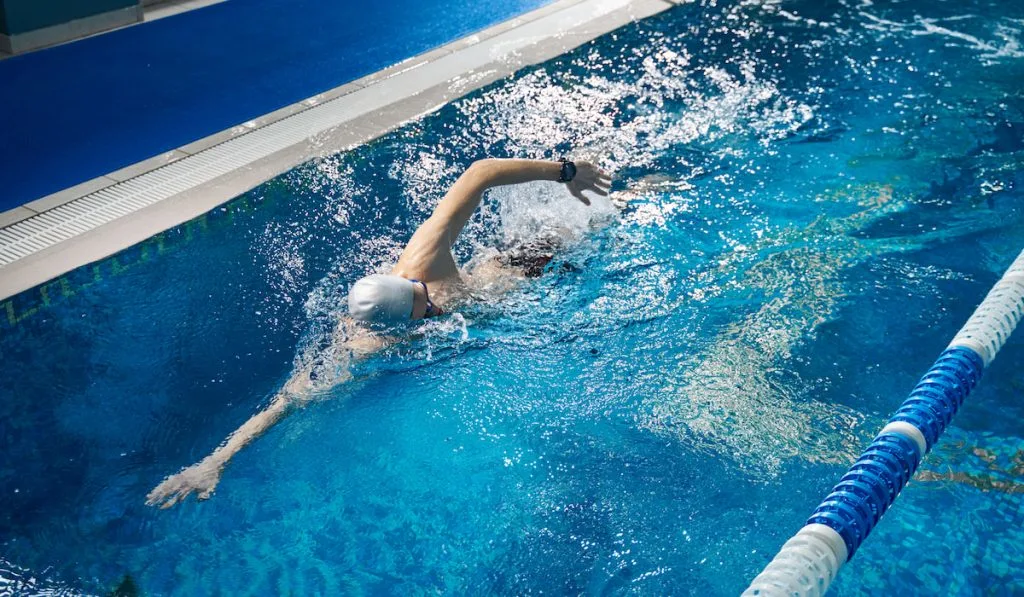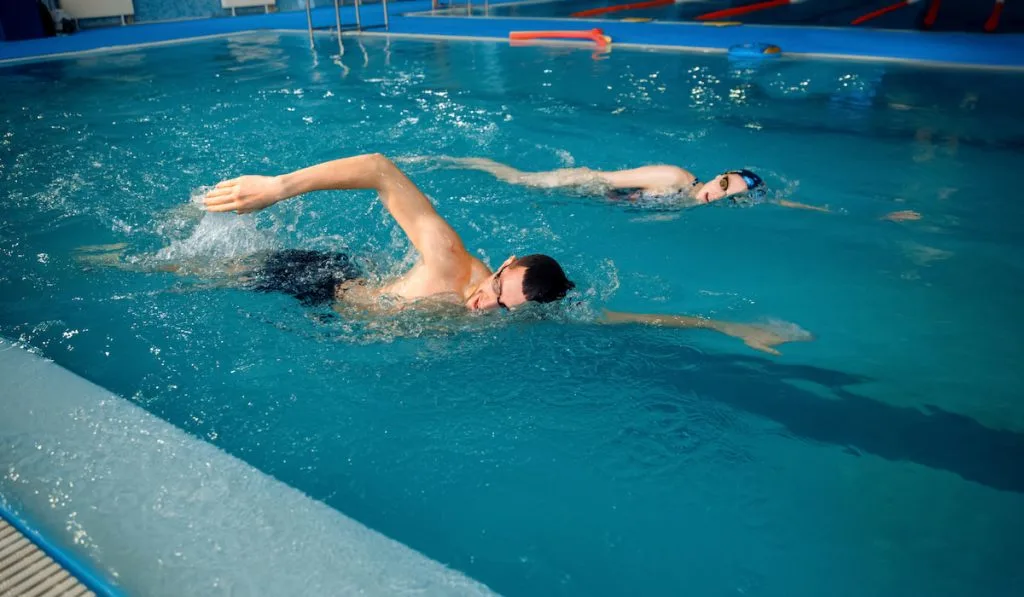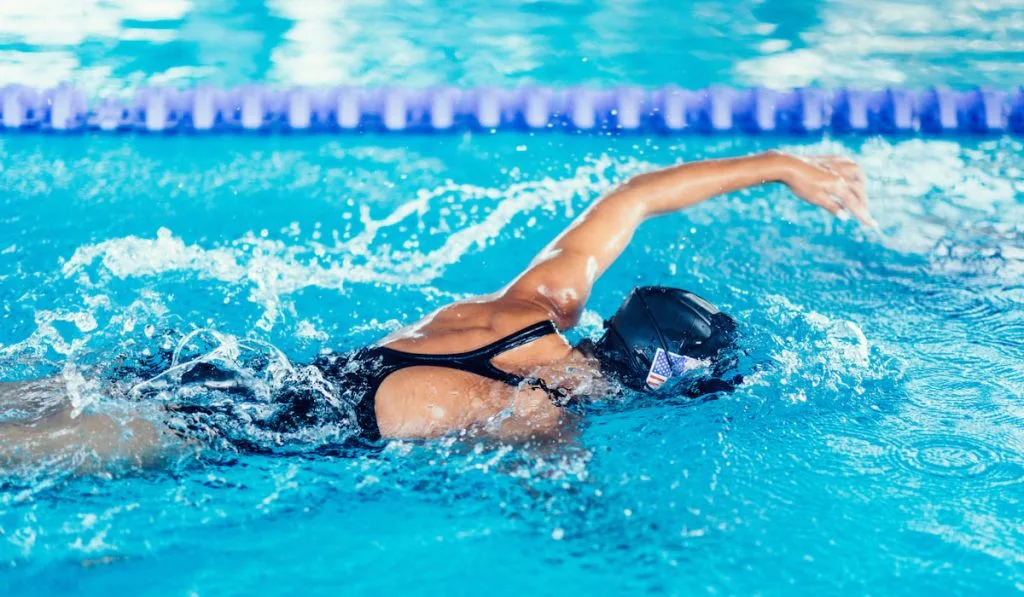Freestyle is currently divided into three different styles: shoulder-driven freestyle, body-driven freestyle, and hip-driven freestyle. Each of them is unique and has its purpose and technique.
Mastering all three can improve your freestyle swimming abilities. However, our focus in this article is the hip-driven freestyle.
What Is Hip-Driven Freestyle?
Hip-driven freestyle is described as the most efficient freestyle technique. It uses aggressive hip rotation to force movement through the water.
Hip-driven freestyle is the ideal technique for longer aerobic distances. It is also used for cooling down and warming up.
The energy required to perform a hip-driven freestyle is less than that for a shoulder-driven freestyle. But while it is energy-efficient, it is not the fastest.
There are certain key elements that must be understood before using this technique. One of these elements includes getting the timing correct.
The Four-Point Connection
When doing the hip-driven freestyle, four things must happen simultaneously. These four things are described as a four-point connection, and they are as follows:
- The hand above the water goes into the water
- Pull through with the hand underwater
- Rotate your hips from side to side
- Kick down with the foot proximal to the bottom

Moving While Doing the Hip-Drive Freestyle
When swimmers use the hip-driven freestyle technique, they do not forfeit vital shoulder rotation. They will want to get as much of that coupling motion required for this freestyle technique.
Swimmers generate fewer strokes with the hip-drive freestyle. So, they must maximize the propulsion they create with each arm stroke. To do this, they must simultaneously use strong hip rotation and good shoulder rotation. The swimmer must also have a firm grip on the water during the underwater pull.
In other words, the swimmer must press backward and hold on to the water through the front and back quadrants, no in-sweeping or out-sweeping. The swimmer must also have a strong kick.
During the pull phase of this technique, there is a lot of downtime where neither hand generates propulsion. But with a strong kick, a swimmer can maintain their speed during the phase.
Another key technique of the hip-driven freestyle occurs at the front and back quadrant of the underwater pull phase. At the front quadrant, the swimmer pushes the hand forward and not downward, delaying the downward lift pull phase.
When using the hip-driven freestyle technique, the pulling hand must be in the early propulsive pull phase once the recovering hand enters the water. This means you cannot delay the pulling motion when doing the hip-driven freestyle.
At the back quadrant of the hip-driven pull, the swimmer pushes longer and harder. They rotate their hips aggressively and release their hands forward to the recovery phase.
The hip rotation described above is why the technique is called hip-driven freestyle.
In hip-drive freestyle, the swimmers aim to get as much distance per stroke as possible since fewer strokes are taken. Due to the slow stroke rate of the hip-driven freestyle, having a strong kick is a big advantage.
The average stroke rate for hip-driven freestyle is around 50-75 strokes per minute. A hip-driven freestyler with a stroke rate of 60 has an arm cycle time of 2 seconds.

When to Use Hip-Driven Freestyle Technique
The hip-driven freestyle technique is used primarily by swimmers for warm-ups and warm-downs. This technique is also used for long-distance swimming 400 meters or longer, especially by swimmers with strong freestyle kicks.
Other instances where hip-driven freestyle technique can be used include:
- Freestyle drills to help swimmers improve hip rotation and pulling motion.
- Open water swimming for athletes that lack the training to maintain hybrid or shoulder-driven freestyle techniques.
Avoid using the hip-driven freestyle technique for sprint distances like the 50-meter or 100-meter events. This technique will not serve you well if you decide to use it for short-distance events.

How to Improve Your Hip Driven Freestyle Technique
To improve your hip-driven freestyle technique, you can use the one-stroke or six-kick drill with fins.
When doing this drill, swimmers focus on the end of the underwater pull. They push hard at the back with the hand close to the hip. Then they snap their hips back, augmenting the force of the pulling hand and increasing their propulsion.
Biomechanically, the end of the underwater pull at the back is not the strongest position for freestyle pull. However, by turning the hips aggressively after the pull, it becomes efficient. Even when the force from the pulling hand has fizzled, the aggressive hip movements will still help increase propulsion.
By using pressure meter technology, it was determined that the maximum force of the pulling hand can be achieved in the back quadrant, front quadrant, or at the shoulder when you transition between the two.
It all depends on the technique you use and the energy you put into your hip or shoulder rotations.
Conclusion
While hip-driven freestyle is an energy-efficient technique, it is not the fastest. It is a technique best suited for long-distance events like the 400 meters and not sprint events.
Hip-driven freestyle is also used for freestyle drills, cooling down, and warming up. But due to the slow stroke of the technique, swimmers using this technique must have strong kicks.
